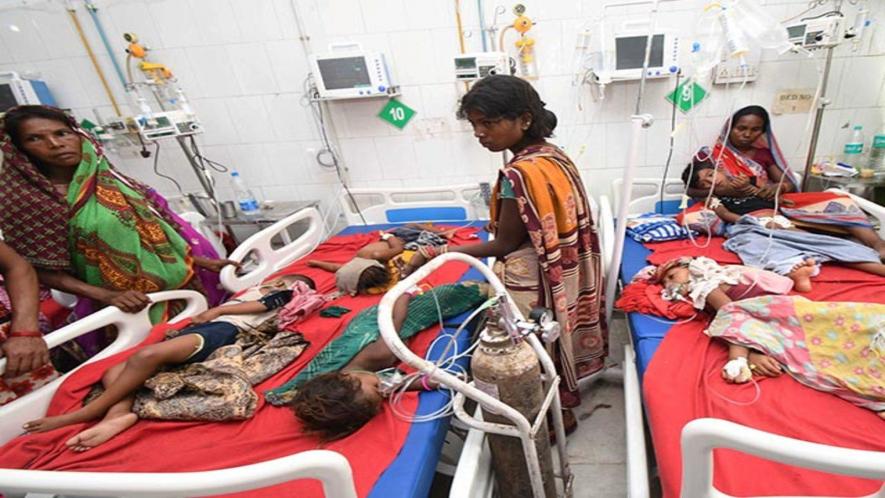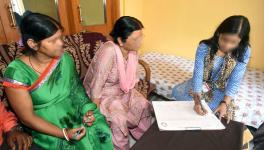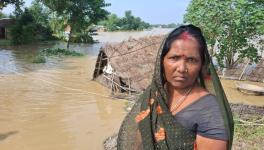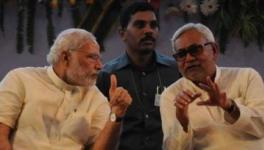Amid COVID-19 Crisis, Bihar Reports 6 AES Cases Ahead of Summer

Image Courtesy: The Economic Times
Patna: With mercury yet to touch 40 degree Celsius by the end of first week of April this year, the fear of outbreak of Acute Encephalitis Syndrome (AES) is haunting Bihar yet again as reports of six minor children with the disease have surfaced so far. All of them have been admitted at the government-run Sri Krishna Medical College and Hospital (SKMCH) in Muzaffarpur district. Of the six AES cases, locally known as chamki bukhar, one child has died, two have been discharged after recovery and three children are undergoing treatment for the disease at the hospital.
Unconfirmed reports suggest that at least four children are suspected to be suffering from AES in Madhubani, Sitamarhi and East Champaran districts as they are showing symptoms of the disease.
Nearly 12 days after Aditya Kumar, a three and half years old son of Munna Ram, resident of Baiju Bujurg village under Sakara block of Muzaffarpur, died of AES on March 29 at Pediatric Intensive Care Unit (PICU) in SKMCH, five children affected by AES have been reported. Aditya was the first reported case of AES this year in the state and he was also the first casualty from the disease in 2020.
At present, three children including Kalpana Kumari, resident of Gaighat block in Muzaffarpur, Mohd Khubaid of Gaighat and Md Arhan of Chakia block in East Champaran district are being treated for AES at SKMCH. Kalpana was admitted on April 6, Khubaid on March 31 and Arhan on March 29.
Dr Gopal Shankar Sahni, head of the SKMCH’s paediatric department, said that their condition is improving fast. “All of them were admitted after they developed symptoms of AES. We have been properly treating them and taking no chance. Hope that they would return home after full recovery,” he said.
However, it has already alarmed the top brass of the state government as they hardly expected AES cases in the last week of March and first week of April. Health experts have repeatedly pointed out that AES cases are reported during May-June when summer is at its peak in Bihar.
Taking note of AES cases reported, Chief Minister Nitish Kumar has asked concerned officials last week itself to be on alert and be fully prepared to check and control its spread at a high-level meeting to review the coronavirus crisis as well as the state’s preparedness to tackle AES .
What has worried the doctors and the health department officials is that when the entire focus is on combating the spread of COVID-19, if the number of AES cases increases, it would be an additional burden on the fragile health infrastructure in the state. “Last year's experience of tackling AES outbreak in Muzaffarpur and half a dozen neighbouring districts was not good,” a health department official of joint secretary rank, said.
But SKMCH superintendent Dr S K Shahi told NewsClick that “we are fully ready and alert to face any situation related to AES”.
“We are already on alert mode and ready with every possible arrangement to deal with any situation.This hospital is fully equipped to handle AES cases this time,” he said.
Shahi said that the hospital has purchased all required medicines and PICUs are “well-equipped with high-tech gadgets” to treat AES patients. He admitted that last year, during the summer (June), the situation was different.
A senior and a junior doctor of SKMCH said that there is no doubt that some preparation has taken place this year, unlike last year, but AES cases reported early “is a big problem as the hospital is already facing a big challenge of dealing with the outbreak of coronavirus”.
Also read: COVID-19 in Rural India-V: Poor Households in Kuloth Having to Work as Agri Labour to Survive
“AES cases may create more trouble for the state that lacks adequate health facilities and is facing shortage of doctors,” they said.
Both of them also questioned the repeated claim of the state government that it has “successfully completed immunisation and awareness campaigns in rural areas to contain AES”, as the immunisation drive was abruptly halted last month following the announcement of lockdown.
According to State Health Society (SHS) officials, immunisation for JE [Japanese Encephalitis] was carried out in 26 districts ahead of the lockdown, but could not be completed in the remaining 12 districts. Officials said that the JE vaccines were administered to 7.89 lakh children in three districts including AES-affected Muzaffarpur ahead of lockdown.
Sensing imminent AES trouble, CM Nitish Kumar had directed health officials to be on alert and start preparations ahead of its outbreak. He also stressed on speeding up of awareness campaigns in rural pockets--mainly half a dozen blocks of Muzaffarpur that had reported maximum AES cases last year and in the past.
The CM has also asked officials to take all possible precautionary measures in areas likely to be affected by AES and take care of sanitation and ensure quick operationalisation of an under-construction 100-bed PICUs at SKMCH.
Bihar Principal Secretary of Health Department Sanjay Kumar said that the government is alert and ready to treat AES cases. “There is no reason to panic after AES cases were reported in March itself; sometimes, it happens. We have worked out a new strategy to deal with the AES cases this time,” he said.
Last year, in June,the AES outbreak in five North Bihar districts had resulted in the death of more than 150 children, as per official numbers. More than 600 children suffering from AES were admitted in the hospitals including.
More than 500 children have died in the last one decade due to AES, mainly in Muzaffarpur and its neighbouring districts of Vaishali, Sitamarhi, Samastipur, Sheohar, East and West Champaran.
More than over two decades after AES first struck Muzaffarpur as an epidemic, the disease not only persists but also continues to spread among the poorer sections. Estimates say that more than 75% of the victims belong to the socially marginalised section – comprising mostly Dalits along with Extremely Backward Classes (EBC) and Muslims. There is hardly any case in which the AES-affected child belongs to a rich and well-off family.
Several socio-economic survey reports of the victims of AES revealed that AES cases are mostly coming from Mushahar, Ravidas, Paswan and Muslim communities due to “their poor living conditions”.
AES usually happens at temperatures above 42 degree Celsius. Health experts said children suffering from AES suddenly develop high fever. Their body temperature shoots up, they suffer from convulsions, weakness and even fall unconscious and slip into a coma and they can die.
On the other hand, as of Thursday, there were 51 COVID-19 positive cases in Bihar, with one person dead. Twelve new cases were reported on April 9. So far, the state had tested more than 4,000 samples, a number far less when compared to its huge population. There are four COVID-19 test facilities in Bihar.
Also read: COVID-19: Poorest of Poor Roaming on Streets for Food and Fuel in Bihar
Get the latest reports & analysis with people's perspective on Protests, movements & deep analytical videos, discussions of the current affairs in your Telegram app. Subscribe to NewsClick's Telegram channel & get Real-Time updates on stories, as they get published on our website.























